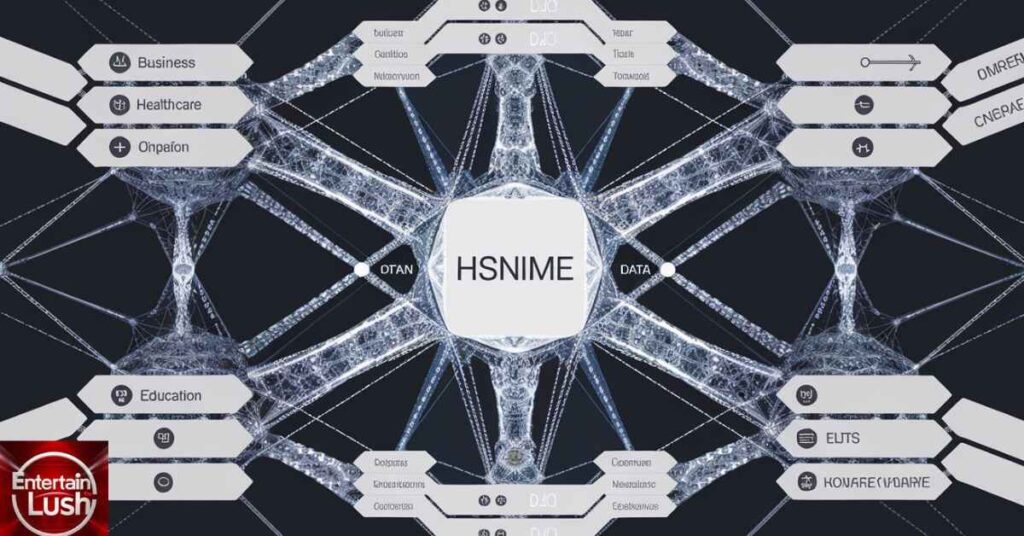Understanding HSNIME can be daunting for many professionals in healthcare, education, and business. The complexity of this powerful data integration system often leads to missed opportunities and inefficient operations.
Without proper implementation, organizations struggle to harness the full potential of their data, resulting in delayed decision-making and reduced competitiveness. This comprehensive guide demystifies HSNIME, offering clear insights into its applications, benefits, and implementation strategies.
From healthcare to education, discover how HSNIME can revolutionize your data management, enhance operational efficiency, and drive informed decision-making across your organization.
What is HSNIME?
HSNIME stands for Health and Social Network Information Management Environment. It’s a system that helps organizations handle large amounts of health and social data. It combines different types of information and makes it easier to use. This tool is valuable for healthcare providers, researchers, and policymakers. It allows them to see patterns and make better decisions based on comprehensive data.
The Evolution of HSNIME
It began in the early 2000s as a response to growing data challenges in healthcare. At first, it focused on medical records. Over time, it expanded to include social factors affecting health. By 2010, the systems started using advanced analytics. Today, they incorporate artificial intelligence and machine learning. This evolution has made it more powerful and useful across various sectors.
The Importance of HSNIME in Today’s Context
In our data-driven world, HSNIME plays a crucial role. It helps organizations make sense of complex information quickly. This is essential for tackling modern health challenges. It enables real-time decision-making and personalized care. It also supports public health initiatives by identifying trends. As health issues become more complex, its importance in managing and analyzing data continues to grow.
HSNIME in Healthcare
In healthcare, HSNIME transforms patient care. It combines medical records, lab results, and social data. This gives doctors a complete view of each patient. It helps predict health risks and suggests personalized treatments. It also improves hospital operations by optimizing resource use. With HSNIME, healthcare providers can offer better, more efficient care to their patients.
HSNIME in Education
Education benefits greatly from HSNIME. It tracks student performance and identifies learning patterns. Teachers use this data to create personalized learning plans. It also helps schools manage resources more effectively. It can predict enrollment trends and adjust curricula accordingly. This technology is making education more adaptive and responsive to student needs.
HSNIME in Business and Finance
It is reshaping business and finance sectors. It analyzes market trends, customer behavior, and financial data. This helps companies make informed decisions quickly. It improves risk assessment in financial services. It also enhances customer experiences through personalized offerings. By processing vast amounts of data, it gives businesses a competitive edge in today’s fast-paced market.
Data Integration and Analysis in HSNIME

HSNIME excels at bringing together diverse data sources. It combines structured and unstructured data seamlessly. The system then applies advanced analytics to this integrated data. This process reveals insights that might be missed otherwise. Its analysis capabilities range from simple statistics to complex predictive models. It turns raw data into actionable information for users.
The Role of Machine Learning in HSNIME
Machine learning is a key component of modern HSNIME systems. It allows HSNIME to learn from data patterns over time. This improves the accuracy of predictions and recommendations. Machine learning in HSNIME can identify subtle trends in large datasets. It also helps in automating routine data analysis tasks. This technology makes it more powerful and adaptive to changing data landscapes.
Cloud Computing in HSNIME
Cloud computing has revolutionized HSNIME implementation. It allows for scalable and flexible data storage and processing. Cloud-based HSNIME systems can handle massive amounts of data efficiently. They also enable real-time collaboration and data sharing. This approach reduces infrastructure costs for organizations. Cloud computing makes it more accessible and powerful for users across different locations.
IoT and Its Role in HSNIME
The Internet of Things (IoT) greatly expands its data collection capabilities. IoT devices provide real-time data from various sources. This includes wearable health monitors and smart home devices. It integrates this data to create a more comprehensive picture. IoT enhances its ability to monitor and respond to changes quickly. This integration is particularly valuable in healthcare and environmental monitoring.
Challenges in Implementing HSNIME
Adopting HSNIME comes with several hurdles. Many organizations struggle with data integration from various sources. Legacy systems often don’t communicate well with new technology. Staff may resist change or lack necessary skills. High initial costs can deter smaller organizations. Technical issues like data quality and system compatibility are common. Overcoming these challenges requires careful planning, training, and investment in infrastructure.
Privacy and Security Concerns
HSNIME systems handle sensitive data, raising privacy and security concerns. There’s a risk of unauthorized access or data breaches. Protecting personal health information is crucial. Organizations must implement strong encryption and access controls.
Regular security audits are necessary. Balancing data sharing for analysis with individual privacy rights is challenging. Clear policies on data usage and storage are essential to address these concerns.
Regulatory Compliance for HSNIME
It must adhere to various regulations. In healthcare, HIPAA compliance is crucial for U.S. organizations. The EU’s GDPR affects data handling for European citizens. Financial sector implementations must follow regulations like SOX. Educational use needs to comply with FERPA in the U.S. Staying updated with changing regulations is challenging. Organizations need dedicated teams to ensure ongoing compliance in HSNIME use.
The Role of Blockchain in HSNIME Security
Blockchain technology is enhancing its security. It provides a tamper-proof record of data transactions. This improves data integrity and traceability. Blockchain can secure patient records in healthcare applications. It also helps in maintaining audit trails for regulatory compliance. The decentralized nature of blockchain reduces single points of failure. This technology is making the systems more resilient against cyber attacks.
Enhanced Decision-Making Processes with HSNIME
It significantly improves organizational decision-making. It provides comprehensive data analysis in real-time. Decision-makers get a holistic view of complex situations. Predictive analytics help in forecasting outcomes. It can identify trends that humans might miss. This leads to more informed and timely decisions. In healthcare, it can improve diagnosis and treatment plans. Businesses use it for market analysis and strategic planning.
Improved Operational Efficiency
HSNIME boosts operational efficiency in various ways. It automates data collection and analysis, saving time. Workflow optimization becomes easier with comprehensive data insights. Resource allocation improves based on accurate predictions.
It reduces manual errors in data handling. It enables quick responses to changing conditions. For example, hospitals can manage bed capacity more effectively. Educational institutions can optimize class schedules and resource use.
Cost Reduction and Resource Optimization with HSNIME

HSNIME plays a key role in reducing costs and optimizing resources. It identifies inefficiencies in processes and resource use. Predictive maintenance schedules prevent costly breakdowns. In healthcare, it can reduce unnecessary tests and treatments.
It helps in inventory management, reducing waste. It optimizes energy use in buildings through smart analysis. By improving decision-making, it prevents costly mistakes. This leads to significant long-term cost savings for organizations.
Read This Blog: Top Trends Wallpaper Designs for 2024: Transform Your Space with Style
Emerging Trends in HSNIME Technology
It is evolving rapidly with new technologies. Artificial intelligence integration is becoming more sophisticated, enabling better predictive analytics. Edge computing is improving real-time data processing.
Natural language processing is enhancing its ability to analyze unstructured data. Quantum computing may soon boost its processing power dramatically. Virtual and augmented reality are being explored for data visualization. These trends are making HSNIME more powerful, user-friendly, and applicable across various fields.
Potential Impact of HSNIME on Various Industries
HSNIME is set to transform multiple industries. In healthcare, it could enable precision medicine and predictive diagnostics. For education, it might create fully personalized learning experiences. In retail, it could revolutionize inventory management and customer experiences. Smart cities could use it for efficient resource allocation.
In agriculture, it might optimize crop yields and reduce environmental impact. The manufacturing sector could see improved supply chain management and predictive maintenance. Its potential to drive innovation across industries is vast.
Also Read: Comprehensive Insights into SBT Labs Business Evaluation 2024
Challenges and Opportunities for HSNIME Adoption
HSNIME adoption faces challenges like data privacy concerns and integration with legacy systems. High initial costs and skill gaps in the workforce are obstacles. However, opportunities are significant. Growing data volumes create a need for better management tools. Increasing regulatory pressures demand more sophisticated compliance solutions.
Planning and Strategy Development for HSNIME
Effective HSNIME implementation starts with thorough planning. Organizations should first identify specific goals and pain points. A cross-functional team should be formed to oversee implementation. It’s crucial to assess current data infrastructure and identify gaps.
Developing a phased implementation plan helps manage resources effectively. Stakeholder communication is key throughout the process. Regular reviews and adjustments of the strategy ensure alignment with organizational goals.
Training and Skill Development for HSNIME
Successful HSNIME implementation requires a skilled workforce. Training programs should cover data analysis, system operation, and interpretation of results. Employees need to understand basic concepts of machine learning and AI. Data privacy and security training is essential.
Soft skills like critical thinking and problem-solving are also important. Organizations can partner with educational institutions for specialized courses. Continuous learning opportunities help staff stay updated with evolving HSNIME technologies.
Measuring HSNIME Success and ROI
Evaluating its effectiveness is crucial for justifying investment. Key performance indicators (KPIs) should be established before implementation. These might include efficiency improvements, cost savings, or improved decision-making speed.
User adoption rates and satisfaction surveys provide valuable insights. Financial metrics like return on investment (ROI) should be calculated over time. Regular audits can assess data quality and system performance. Comparing outcomes with pre-implementation baselines helps quantify HSNIME’s impact.
FAQ
What is the primary purpose of HSNIME?
Its main purpose is to integrate and analyze large volumes of health and social network data. It aims to provide comprehensive insights for better decision-making in various sectors.
How does HSNIME differ from traditional data analysis methods?
HSNIME combines diverse data sources and uses advanced analytics like machine learning. It provides real-time, holistic insights, unlike traditional methods that often analyze data in silos.
What industries can benefit most from HSNIME implementation?
Healthcare, education, and financial services can benefit greatly from HSNIME. These industries deal with complex, interconnected data that it can effectively manage and analyze.
What are the main challenges in adopting HSNIME?
Key challenges include high initial costs, data integration issues, and privacy concerns. Organizations also face difficulties in training staff and ensuring regulatory compliance.
How can organizations ensure data privacy when using HSNIME?
Organizations can use strong encryption, implement strict access controls, and conduct regular security audits. Clear data usage policies and compliance with relevant regulations are also crucial.
Conclusion
HSNIME represents a powerful tool for managing and analyzing complex data across various sectors. Its ability to integrate diverse data sources and provide real-time insights makes it invaluable in today’s data-driven world.
While challenges exist in implementation, the benefits of enhanced decision-making and operational efficiency are significant. As it continues to evolve, it promises to shape the future of data management and analysis, offering new opportunities for innovation and improvement across industries.
Jake is the dynamic author of the entertainment section on Entertainlush.com. With a deep passion for gaming and entertainment, he delivers insightful content that keeps readers engaged and informed. Specializing in the latest trends, reviews, and updates in gaming and entertainment, Jake brings a wealth of knowledge and a keen eye for detail to every piece. Whether you’re a gaming enthusiast or a pop culture aficionado, Jake’s articles offer valuable perspectives and up-to-date information to enhance your entertainment experience.







